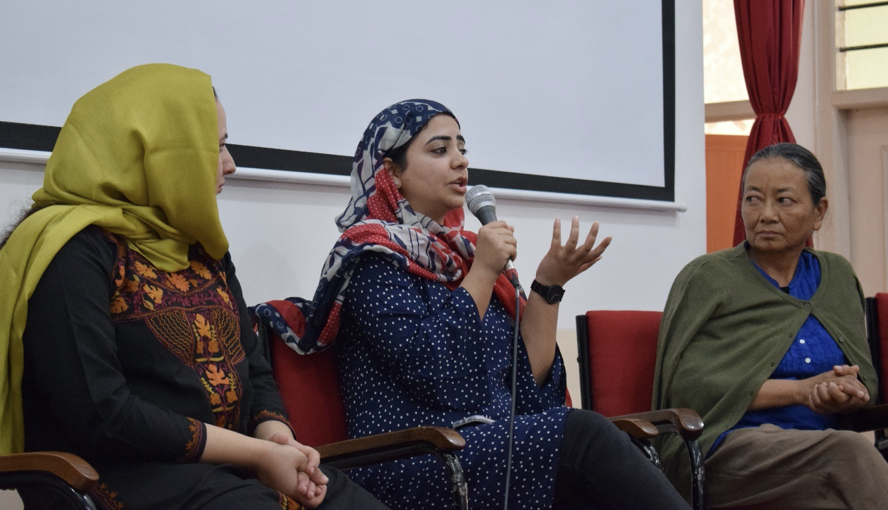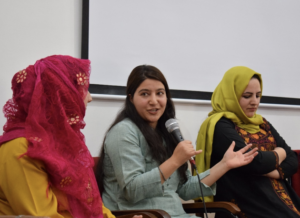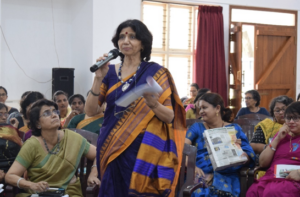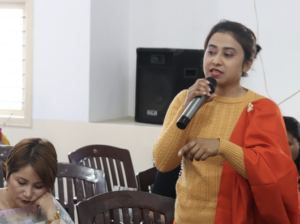DAY 2 : 08 February 2020
SESSION 3: 11.00 – 12.30 pm
Clampdowns and Courage
Six months of the Kashmir blockade

The prolonged, ongoing crisis in Kashmir has been pushed to the margins today. The situation in the erstwhile state remains grim and intolerable; the communications shutdown continues, with internet services suspended for over five months. The status of Kashmir has been a sensitive and contentious political issue for successive governments and many people in “the rest of India”. How can journalists bring the realities of life in Kashmir, especially in the wake of the events of 5 August 2019, to light? What are the stories of ordinary people, especially women and children, that remain to be told? What are the problems faced by Kashmiri journalists in general and women journalists in Kashmir in particular over the past six months? What can journalists from elsewhere do under the circumstances?
Moderators: Geeta Seshu, Laxmi Murthy
Initiators of the discussion: Raihana Maqbool, Rifat Mohidin, Shahnaz Marouf, Masrat Zahra, Linda Chhakchhuak (bringing in a perspective from the marginalised Northeastern region)
Geeta Seshu, the co-moderator, began the session by expressing appreciation for the NWMI’s role in enabling the fact-finding report on the situation of the media and journalists in Kashmir, titled “News behind the barbed wire,” along with the Free Speech Collective (FSC), in September 2019. She underlined the fact that, despite the unprecedented lockdown, the practice of journalism continues in Kashmir.
Before the session got underway she requested participants to switch off their mobile phones during the session as one way to begin to understand and appreciate what being cut off from any means of communication is like. Later, at the end of the session she pointed out that if not having access to phones for such a short time had caused so much inconvenience and anxiety, it is important to think about how journalists in Kashmir had continued to work without phone and internet services for such a long period. At a time when instant communication is taken for granted, she said, their experience of managing without it can provide a lesson on agility and resilience. She pointed out that journalists require technology to capture stories, write or shoot photographs or videos, and send them to editors. Even the process of working on a story involves communication as there are sources to be contacted, colleagues to be coordinated, etc. To function as a journalist without a phone and internet connection is highly challenging, to say the least.
Marouf Gazi pointed out that the period since August 2019 had been one of the most traumatic times in the lives of Kashmiris. “The most certain thing about Kashmir is uncertainty,” she said.

According to her, an impression has been created that 2G mobile services have been restored and that, therefore, normalcy has been restored. But, on the ground, it is a different reality, she stressed. The situation has obviously had an impact on the practice of journalism. It has also led to trauma linked to how uncertain everything is.
Describing her own experience of the clampdown, she said, “On 4 August I was sitting near the river Jhelum, talking with a friend, when I received a WhatsApp message saying I should go back home because something big was going to happen. There was panic in the air. I went home and had to stay put there till 22 August. There was curfew, no landline/mobile or internet connection, no communication with anyone. It was psychologically traumatic. When it was finally possible to leave the house, I remember walking for miles to find a working landline, leaving home early in the morning to buy essentials.
When the Government of India revoked the special status of Jammu and Kashmir under Article 370 of the Indian Constitution on 5 August, it also meant a complete lockdown on communication. This was one of the most severe crises in Kashmir’s history and the media had to deal with the most difficult communication blockade ever while trying to convey the ground reality of what was happening in Kashmir to the world during the (then) six-month long shutdown.
In Kashmir, uncertainty is the biggest reality, she reiterated. The 2G internet service which began functioning in the state (now Union Territory) after a few months of no internet access at all is of no practical use, especially to journalists. According to her, sending stories to editors and media houses is not possible with this service. As of February, there was still no broadband service in Kashmir.
The sense of trauma in the minds of every Kashmiri is naturally present even among journalists, said Marouf. “Our safety and the safety of our family causes deep fear. When the curfew was imposed, first the internet and broadband services were suspended, followed by landline service, too, getting locked out. We had no information about even family members living within Kashmir and in various parts of India. In addition, we were completely severed from the rest of the world in terms of communication. The prolonged curfew and being restricted to our homes affected our psyche. Whenever I had to go out, even to procure household essentials, I had to be accompanied by my father.
Nocturnal raids used to happen after midnight. There was so much tension that I couldn’t sleep anyway. Around 1am one night I heard footsteps outside. I looked out of the window and saw J&K police going towards a house in the neighbourhood. I heard a woman wailing, and a man with a helmet on his head calling out names from a list (he even knew nicknames). Several youngsters were taken away and remained in custody for a month.
It is important to remember that not only people who are directly or indirectly involved in politics, but even those who are not at all involved, are affected by this lockdown: there is no escape.
During the curfew, going out of the house was out of the question because people monitoring the curfew and people’s movements failed to realize that there could be a medical emergency or that people do need to buy essential household supplies. They would ask, “Why are you outside your home? Do you think lambs have died here? Do you have no respect for the lives that have been lost?”
The last time I went out to work I was with Rising Kashmir. When I finally managed to go to the office, everything inside was covered with dust. We would leave notes in the office for our colleagues to indicate that we were all right and to communicate where and when we would meet for work. All this naturally caused trauma to journalists having to work in the absence of normal communication services.
 Raihana Maqbool, who works with Global Press, pointed out that the national media has been disseminating a lot of propaganda, with their reports hardly reflecting the ground realities in Kashmir after the scrapping of Article 370. “On 4 August 2019, one day before Article 370 was revoked, there had been frantic interaction in our WhatsApp groups, expecting something big to happen the next day but not knowing what will happen,” she said. “We had no idea that even our landline services would be stopped. The next day, when we got to know through TV reports that Article 370 was gone, we were shocked. That day, when we went out, we saw that no one was there on the streets, not a soul. There were barbed wires in front of my house and every lane was manned by security forces who did not want anyone to come out of their homes.
Raihana Maqbool, who works with Global Press, pointed out that the national media has been disseminating a lot of propaganda, with their reports hardly reflecting the ground realities in Kashmir after the scrapping of Article 370. “On 4 August 2019, one day before Article 370 was revoked, there had been frantic interaction in our WhatsApp groups, expecting something big to happen the next day but not knowing what will happen,” she said. “We had no idea that even our landline services would be stopped. The next day, when we got to know through TV reports that Article 370 was gone, we were shocked. That day, when we went out, we saw that no one was there on the streets, not a soul. There were barbed wires in front of my house and every lane was manned by security forces who did not want anyone to come out of their homes.
When the Media Facilitation Centre was set up by the government, providing space, laptops and basic internet services for journalists in Kashmir, my experience with accessing the internet was bizarre. When I logged in, the system asked me for authentication via SMS, which of course was not working. So, I was unable to reach my editors or file stories using this network. What I did to address this problem was to take a flight to New Delhi, from where I could call my editors on the phone and seek their advice. They told me to practice caution and not to use the media centre network to file stories or communicate with them since they feared the activities of journalists were being monitored by the state. During this lockdown period, I filed my stories on health, detained persons, human rights violations, security, etc., from New Delhi, where I would go for two or three days at least two or three times a month.
The past six months have been the worst period I have experienced in Kashmir. But I must say that, despite all the restrictions and limitations, local journalists did excellent stories for international media – unlike the national media, which were trying to portray everything as normal in Kashmir.
During our movements within Kashmir, when the police, army or paramilitary forces asked us who we were or why we were going to a particular place, we had to decide whether or not it was a good idea to say we were journalists. Telling them the truth could lead to their stopping us from proceeding, which would prevent us from doing any reporting, and not telling them the truth could compromise our own safety and security.
“As a woman journalist I was more privileged than male journalists when it came to getting permission to shoot pictures during the clampdown in Kashmir,” said photojournalist Masrat Zahra.
“During the total shutdown I was initially confined to my house. Whenever I left home on my scooty, my aunt would ask me how they would know if I am safe now that phone and internet connections were gone. At 9.30 am on 5 August, I told my aunt that I had to go out – it’s my job: I have to document what’s going on. I reassured them about my safety and told them to have faith in God.”
“There was lot of barbed wires on the road, and every house was manned by two or three members of paramilitary forces. A few women who were coming out of their houses were stopped by the security forces and asked to go back home. When I was stopped by a security person and he refused to let me go any further, I negotiated with him, pointing out that, just as he was doing his duty, I was on duty as a journalist and it was necessary that I be allowed to proceed. I found that he was able to relate to that argument because he allowed me to go past the barrier.
“When I met various (male) journalists and asked if they had taken any pictures I found that they had not been able to shoot anything because they had not been allowed to. As a woman journalist, I had an advantage under the prevailing circumstances. So, I took charge of taking pictures. But even after overcoming various barriers and managing to get the necessary permissions from security personnel, there was the problem of how we (journalists) would communicate to each other to coordinate our plans to document the clampdown in Kashmir.
“Eventually we decided to work in groups. We would wait in one place for each other for 2-3 hours and relied mainly on word of mouth. When something big was about to happen, we tried to get together, shooting pictures from across the barbed wires on the road. Police would shoo us away and tell us not to come. One policeman told me, ‘I will beat you with my shoe all the way till Governor’s house.’ That was the kind of personal harassment and tussle with security forces that journalists had to undergo to keep reporting from Kashmir during that time. Local journalists were constantly fearful that we would be detained. Whenever our stories got published in the evening, we would be afraid of receiving a phone call with someone asking us why we wrote that story. My parents used to earlier call me 10-15 times a day to enquire about my safety but during the clampdown they had no information about my whereabouts and had to live in fear of the unknown and the danger I could be in.”
Masrat said they managed to go to north Kashmir, where horrifying incidents were happening daily, to document an incident in which a boy was used as a human shield. A girl studying in school was kicked in the abdomen. She vomited blood and was unable to appear for her Class 10 board exams as a result of the injury.
She ended by saying, “I thought I should speak about the worst times in Kashmir because speaking is my form of protest.”
“The good times don’t test journalists, the bad times do,” said independent journalist Rifat Mohidin. “I was guided by this principle and resolved to tell the world about what is happening in Kashmir. We are yet to tell the full story. Kashmir has been turned into a graveyard of silence.”
Newspapers are the most important media platform in Kashmir, she explained, because there are no private television channels in the state. She said witnessing the suffering of the Kashmiri people during the unprecedented communications clampdown and curfew disheartened her to such an extent that she did not know what to report anymore: “I would think to myself, what is the use of my reports, what will change by writing about all the sufferings of people in Kashmir?” According to her, whatever people heard about what happened in Kashmir after 5 August 2019 was just the tip of the iceberg because very little information trickled out.

“The media centre was set up but I believe it was not meant for local journalists,” she said. According to her, it was known as the “sub jail” because of the control and surveillance prevalent there. Nevertheless, she said, somehow colleagues have managed. “The government issued press releases, brought many journalists from outside who were put up in hotels in Srinagar,” she revealed. “But for local journalists, our words and our space were controlled. Clearly, the government had a plan to show to the world that everything was okay in Kashmir through journalists they got from outside and by silencing local journalists who knew the reality of people’s suffering. The local journalists wanted to do their work but the situation did not allow them to function. However, in spite of all the barriers, the local journalists still did their best. The courage of Kashmiri journalists needs to be appreciated.”
According to her, the real stories die in Kashmir because it is not easy to prove that they are happening or have happened, given the stark power imbalance between the government/security forces and the common people. “Gathering evidence is near impossible,” she said. “The thought that predominates in the minds of local journalists is, ‘I am a small person and I will get into a big problem by doing this story.’ I felt like a failure as a journalist during that time. I couldn’t even get to know what was happening due to the communications blockade. I sincerely believe that the real stories haven’t come out yet.”
Local journalists are also anxious about the possibility that their stories will get the individuals or families referred to in reports into trouble, she said. They worry that even if their stories did not get published, the people in them could get exposed, questioned, harassed and even detained. According to her, every journalist in Kashmir considers quitting at one point or the other. “If we stay on, we have to let them (the government) know what we are doing (or reporting) because privacy is no longer a choice for Kashmiri journalists.”
Co-moderator Laxmi Murthy reminded the audience that it is important to keep in mind the larger context of the Kashmiri media. Kashmir has had independent media houses since the 1990s but they operate under major financial constraints. Government advertisements, among the few sources of revenue, cannot be depended upon. The situation now is part of a longer clampdown on Kashmiri media. The so-called national media have no credibility in Kashmir. “We need to think about why the mainstream Indian media has failed in the context of Kashmir,” she said.
“How we as media persons are not reacting to how the local media in Kashmir are functioning during this lockdown is food for thought,” said Meghalaya-based Linda Chhakchhuak. “Unless we react, how can we find a solution?”
“What has been shared here today is such a long, intense experience; it makes one feel as if the rest of the media in the rest of the country are dead,” she continued. “I am reminded of the story of the frog and hot water. The frog’s skin keeps adjusting to the rising temperature of the water until, when it reaches 100 degrees, it dies. Having gone through a similar process, it seems as if the Indian media is comatose now.”

She pointed out that the northeast has experienced similar situations off and on – whenever people’s organisations in the region’s various states agitate. “We have also experienced shorter periods of internet shutdowns recently in response to protests in Assam, Tripura, Manipur, Mizoram and Meghalaya against the CAB/CAA. And the region has experienced similar clampdowns over the years, but not with the same intensity as in Kashmir. In the northeast we have conflicts at different levels: with the Government of India, within the state, among tribes, etc. When the situation gets too tense to handle, the government imposes an internet ban,” she said commiserating with the Kashmir clampdown.
According to Linda, there is lack of understanding about what’s happening in the north east in the rest of the country. “To interpret people’s expression and assertion of their identity and their attempt to ensure their own survival as xenophobic is inappropriate and insensitive. As a media professional, I request everyone to refrain from using that word while reporting on news from the north east.”
Summing up, Geeta Seshu reiterated that journalists need to have empathy even if we do not always understand a situation completely. “Everyone needs to think about the growing insensitivity in mainstream media and do our part as a community to tackle it,” she concluded.
During the discussion that followed, Dhanya commented on the lack of credibility of the English mainstream media while reporting on Kashmir, saying that it is important to use regional media for resistance, and for the true picture to come out.
Bharathi from Navodayam said, “I felt breathless hearing about the lives of the panelists from Kashmir. But the fact that five women have come out from Kashmir and are fighting to continue their work as journalists comes as a life-saving breath of fresh air.” She put into words what many in the audience felt after having listened to the detailed, first-hand experiences shared by colleagues from Kashmir.


